Geothermal Energy
How GE is used in Iceland
Steam Power in Iceland
High and Low Temp Fields
Icelandic Spaas
Thermal Waters of Hungary
Geothermal Energy
Geothermal Energy in Hungary
Spas in Budapest
Spas in Hungary
How GE is used in Iceland
Steam Power in Iceland
High and Low Temp Fields
Icelandic Spaas
Thermal Waters of Hungary
Geothermal Energy
Geothermal Energy in Hungary
Spas in Budapest
Spas in Hungary
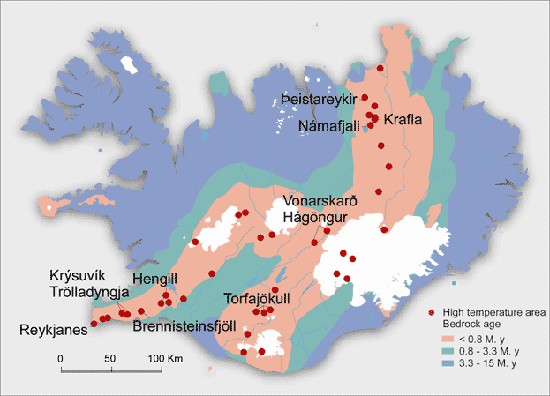
When Ingólfur Arnarson settled first in Iceland his slaves saw first that there was "smoke" rising from the ground. Therefore they called the Icelandic capital Reykjavík or in english "Smokey Bay". But the smoke which the Icelandic capital is named by is not a result of fire but steam rising from hot springs. It was thought at first that the use of geothermal springs was only for washing and bathing. The best known examples are the Þvottalaugar (Washing pools) which is now known as Laugardalur in Reykjavík (Smokey Bay) and also the pool where writer Snorri Sturluson bathed at his farm in Reykholt.
The first trial wells for hot water were sunk by Eggert Ólafsson and Bjarni Pálsson, at Þvottalaugar in Reykjavík, in 1755-1756. More wells were drilled by Þvottalaugar in the coming years in search for hot water for house heating. The first building in Iceland to be heated by geothermal water was Austurbæjarskóli, a school in Reykjavík which was connected to the geothermal pipeline from Þvottalaugar. Soon after that more public buildings in the Reykjavík area were heated by geothermal water obtained through a well which was connected to the pipeline from Þvottalaugar. Today the Reykjavik District Heating supplies the city and several neighboring communities with geothermal water. In Reykjavik there are about 113.850 inhabitants, living in about 35.000 houses. Total harnessed power of the utility's geothermal fields, including the Nesjavellir plant, amount to 660 MWt, and its flow of 55 million cubic meters of water.
A mixture of geothermal water and steam is pumped up from drilled wells in the ground in to a central separation station where the steam is separated from the geothermal brine. After the separation, the steam is piped trough moisture separators to steam heat exchangers inside the plant building. In the steam heat exchangers, the steam is cooled under pressure to condense the heat which is then transferred to cold fresh water in condensating heat exchangers. The condensate cools do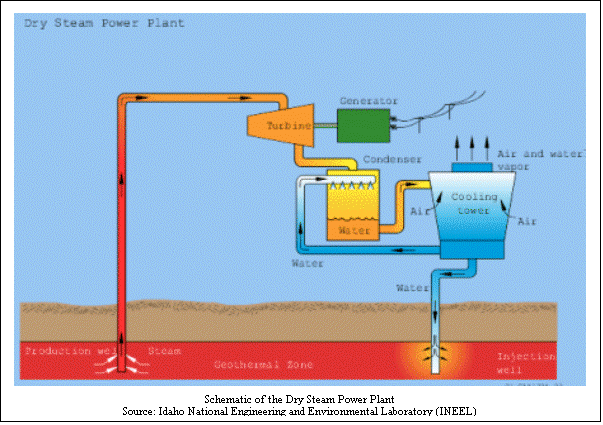 wn in the process to 20°C. Separated geothermal water has its heat transferred to cold fresh water by geothermal brine heat exchangers. Since the mineral-rich geothermal brine causes scaling that coats the heat exchanger pipes, steel particles are allowed to circulate in the stream, impacting against the pipes to remove any scaling as it occurs. Cold groundwater is pumped from to a storage tank by the power house. From there, it is pumped to the heat exchangers where its temperature is raised to 85-90°C.
wn in the process to 20°C. Separated geothermal water has its heat transferred to cold fresh water by geothermal brine heat exchangers. Since the mineral-rich geothermal brine causes scaling that coats the heat exchanger pipes, steel particles are allowed to circulate in the stream, impacting against the pipes to remove any scaling as it occurs. Cold groundwater is pumped from to a storage tank by the power house. From there, it is pumped to the heat exchangers where its temperature is raised to 85-90°C.
Since the fresh water is saturated with dissolved oxygen that would cause corrosion after being heated, it is passed through deaerators where it is boiled at low vacuum pressure to remove the dissolved oxygen and other gases, cooling it to 82-85°C. Then the water is ready for use.
But making the water ready for use is only 1/3 of the work. After that you have to send it to the place where it is used f.e. a town where it is used to warm up houses. And also you have to get rid of the waste geothermal water.
Geothermal heating plants in high-temperature fields only utilize the thermal energy of the geothermal fluid, which, after use in heat exchangers must be disposed of with minimum risk to the environment. This disposal can be performed in two different ways, i.e. at surface or into subsurface aquifers. Surface disposal can be carried out in a similar way to the natural disposal of flow from the hot springs, i.e. into the brook in the Nesjavellir valley, which disappears into a lava field before reaching Lake Þingvallavatn. Subsurface disposal requires that the waste water is pumped back into the geothermal reservoir. This latter method is obviously more friendly to the environment but more expensive. And that is considered to be one of the biggest negative factors about these steam power plants. It can also be more difficult to operate due to scaling in the reinfection wells and their aquifers.
There are two important features of the waste water from high-temperature fields that may have a negative effect on the environment. These are the raised temperature of surface waters and ground water aquifers and the presence of hazardous chemicals in the waste water, i.e. arsenic, mercury, boron, etc.
But the positive part about using geothermal energy is that it does have the smallest negative effect on the nature and the ozone-layer (different from other energy sources e.g. nuclear power plants).
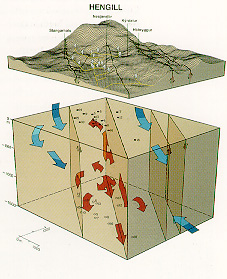 The Hengill geothermal area is one of the largest high-temperature fields in Iceland. It is just about 30 kilometers away from Reykjavík. Reykjadalur and Hveragerði are part of the Grensdalur system, which is now considered extinct. North of this is the Mt. Hrómundartindur system, which last erupted about 10,000 years ago. Geothermal activity in the Ölkelduháls area is connected to that system. To the west of these fields is the Mt. Hengill volcanic system, with its fissure swarms running southwest to Innstidalur, Kolviðarhóll and Hveradalur, and northeast via Nesjavellir to Lake Þingvallavatn.
The Hengill geothermal area is one of the largest high-temperature fields in Iceland. It is just about 30 kilometers away from Reykjavík. Reykjadalur and Hveragerði are part of the Grensdalur system, which is now considered extinct. North of this is the Mt. Hrómundartindur system, which last erupted about 10,000 years ago. Geothermal activity in the Ölkelduháls area is connected to that system. To the west of these fields is the Mt. Hengill volcanic system, with its fissure swarms running southwest to Innstidalur, Kolviðarhóll and Hveradalur, and northeast via Nesjavellir to Lake Þingvallavatn.
The Hengill system has erupted a number of times in past times, and occasional earthquakes are still felt at Nesjavellir, as elsewhere in the area. Some 2,000 years ago, the Nesjahraun lava field was created by a eruption along Nesjavellir, which created the island of Sandey in Þingvallavatn (Lake). Drilling has shown that heated water is found at depths of 1-3 kilometers.
The greatest geothermal activity at surface level was found in the south of Nesjavellir. Therefore exploration by drilling was focused on that area. The extent of the area of the geothermal distribution was also studied at a depth of 1-2 km to the east, west and north. The conclusions of these studies can be arranged in a model of the geothermal system which shows the flow of boiling water from under Hengill along Kýrdalshryggur on to Nesjavellir. Between Kýrdalshryggur and Köldulaugagil geothermal energy is found at a depth of one kilometer, but at a greater depth the temperature is highest in the Kýrdalshryggur. At still greater depths the geothermal system extends beneath Nesjavellir and Kýrdalur.
 The Nesjavellir power station is situated at 177 meters above sea level. The water is pumped through a main pipeline of 90 cm in diameter to a storage tank in the Hengill area at 406 meters. From there the water flows by gravity , through a pipeline which is 90 cm. in diameter, to storage tanks on Reynisvatnsheiði and Grafarholt on the eastern outskirts of Reykjavík. Those tanks are 140 meters above sea level, and have control valves to regulate the flow of water through the pipeline and maintain a constant water level in the tank in the Hengill area. From the storage tank, near Reykjavík, the water is fed through pipelines to the communities which are served by Hitaveita Reykjavíkur. From Nesjavellir to Grafarholt, the transmission pipe measures about 27 kilometers in length. It is designed to carry water at up to 96 °C, with a transmission rate of 1870 liters/s. During phase I of the project, its flow rate was around 560 liters per second, whereby the water took 7 hours to run the length of the pipe and cooled by 2°C on the way. Good insulation and a high volume of water are the most crucial factors contributing to this low heat loss. At later construction stages at Nesjavellir, the flow rate will be tripled, reducing the heat loss to less than 1°C. The steel pipe is insulated with rock wool and covered with aluminum sheets where it lies above the ground, and insulated with polyethylene and covered with PEH plastic where it lies underground. Its high insulating properties are shown by the fact that snow does not melt on the part that lies above the surface. For environmental and traffic reasons, a 5 km section of the pipe is underground. The surface section also runs under automobile crossings at several points which have been well marked.
The Nesjavellir power station is situated at 177 meters above sea level. The water is pumped through a main pipeline of 90 cm in diameter to a storage tank in the Hengill area at 406 meters. From there the water flows by gravity , through a pipeline which is 90 cm. in diameter, to storage tanks on Reynisvatnsheiði and Grafarholt on the eastern outskirts of Reykjavík. Those tanks are 140 meters above sea level, and have control valves to regulate the flow of water through the pipeline and maintain a constant water level in the tank in the Hengill area. From the storage tank, near Reykjavík, the water is fed through pipelines to the communities which are served by Hitaveita Reykjavíkur. From Nesjavellir to Grafarholt, the transmission pipe measures about 27 kilometers in length. It is designed to carry water at up to 96 °C, with a transmission rate of 1870 liters/s. During phase I of the project, its flow rate was around 560 liters per second, whereby the water took 7 hours to run the length of the pipe and cooled by 2°C on the way. Good insulation and a high volume of water are the most crucial factors contributing to this low heat loss. At later construction stages at Nesjavellir, the flow rate will be tripled, reducing the heat loss to less than 1°C. The steel pipe is insulated with rock wool and covered with aluminum sheets where it lies above the ground, and insulated with polyethylene and covered with PEH plastic where it lies underground. Its high insulating properties are shown by the fact that snow does not melt on the part that lies above the surface. For environmental and traffic reasons, a 5 km section of the pipe is underground. The surface section also runs under automobile crossings at several points which have been well marked.
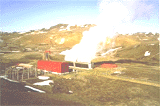 The Krafla power plant is one of two geothermal steam plants run by Landsvirkjun which is the biggest energy producer in Iceland. The other is at Bjarnarflag, also in the Mývatn district. The Krafla station was a topic of debate right from the beginning its construction provoked a major public controversy.
The Krafla power plant is one of two geothermal steam plants run by Landsvirkjun which is the biggest energy producer in Iceland. The other is at Bjarnarflag, also in the Mývatn district. The Krafla station was a topic of debate right from the beginning its construction provoked a major public controversy.
For years, there were doubts that the power station would ever go on line, as major volcanic activity started only about two kilometers away from the plant and posed a real threat to its existence. In spite of this, construction continued, and the plant started operations early in 1977. Landsvirkjun bought the plant from the Icelandic state in 1986.
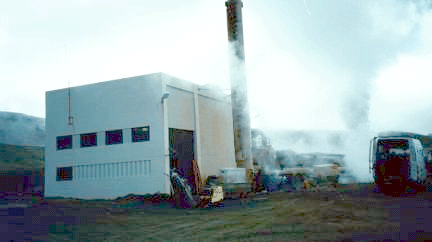 Situated near Lake Mývatn in northeast Iceland, Bjarnarflag Geothermal Station is the smallest power station owned by Landsvirkjun. To generate its 3 MW of electrical energy, the station uses steam from the geothermal field by Námafjall. Laxá Power Company had the station built in 1969, and Landsvirkjun acquired it on 1 July 1983, when Laxá Power Company merged with Landsvirkjun. Furthermore, the steam supply system at Bjarnarflag was bought by Landsvirkjun from the State Geothermal Services this system provides not only Bjarnarflag Geothermal Station with steam to produce electricity, but also supplies steam for example to the Kísiliðjan Diatomite Plant and the Mývatn district heating system. The energy generated by the Bjarnarflag station amounts to approximately 18 GWh per year.
Situated near Lake Mývatn in northeast Iceland, Bjarnarflag Geothermal Station is the smallest power station owned by Landsvirkjun. To generate its 3 MW of electrical energy, the station uses steam from the geothermal field by Námafjall. Laxá Power Company had the station built in 1969, and Landsvirkjun acquired it on 1 July 1983, when Laxá Power Company merged with Landsvirkjun. Furthermore, the steam supply system at Bjarnarflag was bought by Landsvirkjun from the State Geothermal Services this system provides not only Bjarnarflag Geothermal Station with steam to produce electricity, but also supplies steam for example to the Kísiliðjan Diatomite Plant and the Mývatn district heating system. The energy generated by the Bjarnarflag station amounts to approximately 18 GWh per year.
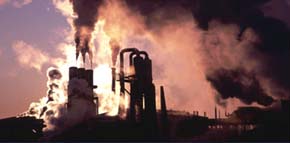 Svartsengi is a power plant just about 30 years old and is situated on Reykjanes. It is owned by the local communities in the Suðurnes. From Svartsengi the geothermal energy is harnessed for the area. The waste water from the plant work is best known as the Blue lagoon which is definitely one of the most famous tourist
attraction in Iceland.
Svartsengi is a power plant just about 30 years old and is situated on Reykjanes. It is owned by the local communities in the Suðurnes. From Svartsengi the geothermal energy is harnessed for the area. The waste water from the plant work is best known as the Blue lagoon which is definitely one of the most famous tourist
attraction in Iceland.
Written by Denis, Elvar und Kalli